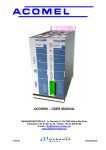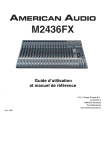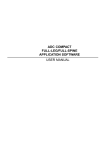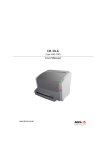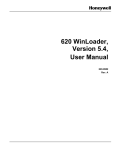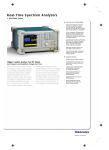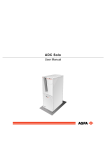Download Dose Monitoring - The Captured Image
Transcript
ADC COMPACT DOSE MONITORING SOFTWARE USER MANUAL TABLE OF CONTENTS Why Dose Monitoring? 1 What is Dose Monitoring? 2 What is measured ? 3 How to use the Dose Monitoring Software Dose deviation indicator Abnormal indications 7 The actual dose level lgM 9 Determining the reference levels 10 How self-calibration works 10 Using the Dose Monitoring Software 13 Special functions 17 Useful Guidelines 25 Defining optimal doses 25 Activating the Dose Monitoring 25 Using the system 26 Fine-tuning the Statistics List 26 Performance requirements ADC Compact Dose Monitoring Software 6 6 27 2208A GB 199801 i ii 2208A GB 199801 ADC Compact Dose Monitoring Software Why Dose Monitoring? In computed radiography the image density is automatically adjusted by the image processing independently of the applied dose. In fact, this is one of the key advantages of the new technology. It helps to reduce the retake rate significantly, but at the same time this feature may hide occasional or systematic under- or overexposure. While in conventional radiography the amount of exposure is directly related to average density, in computed radiography it determines the signal-to-noise ratio, not the image density. The higher the dose, the better the SNR. This is good news as such, but in the long term there is a risk of gradually drifting to higher doses, as the more exposed images tend to look better. For that reason Agfa has developed a quality control tool called “ADC Compact Dose Monitoring Software”. ADC Compact Dose Monitoring Software 2208A GB 199801 1 What is Dose Monitoring ? The ADC Compact Dose Monitoring Software is an optional software package that supplies numerical and visual feedback on the actual median dose captured in the imaging plate with respect to an examspecific reference level. Once the software package has been properly installed and calibrated, it determines the median absorbed dose in each digitized image, and compares this figure with a stored reference dose. The current deviation from the reference dose is shown in the footer of images displayed on the image processing or preview monitors, in case the ADC Compact Preview Software has been installed and is also printed as a bar indicator at the bottom of the hardcopy image. For each distinct examination case the dose may differ, therefore an entire table of reference levels is maintained internally, one for each case. The dose setting policy - for which the radiologist is responsible - generally differs from hospital to hospital. Therefore, the reference levels are not fixed in advance by the manufacturer. These must be established in the hospital where the system is in use, according to prevailing practice. Reference levels for the most frequently applied examination cases are automatically determined by means of a self-calibration programme, which is incorporated in the ADC Compact Dose Monitoring Software. During normal operation the system automatically records the dose level for each exam type encountered. These records are used as a basis for determining the reference levels. This means that the Dose Monitoring Software does not explictly impose any dose settings to the user. On the contrary, it adapts itself to the actual dose levels that are being applied in the hospital over a calibration period. Once calibrated the Dose Monitoring Software stores the reference levels, and for each subsequent exposure it informs the operator in case of significant deviation from reference. As a result dose monitoring will stimulate applying constant doses, and at the same time provide the flexibility to cope with distinct dose requirements for specific examination cases, and even with varying preferences of different departments and hospitals. 2 2208A GB 199801 ADC Compact Dose Monitoring Software What is measured ? In the ADC Compact Digitizer the photomultiplier gain is adjusted to the expected range of dose for each examination case. The gain is specified by the readout exposure class, which is set for each examination to the appropriate value using the ADC Compact ID software. The large dynamic range of 500:1 provides for ample margin both for under- or overexposure. Shifts of the actual dose range are automatically compensated by image processing, as long as the operating range of the detector is not exceeded. Thus constant density is guaranteed despite dose fluctuations. Although image density shift as the direct consequence of inappropriate dose control is eliminated by image processing, the main reason for carefully applying the correct dose remains, i.e. achieving constant image quality and avoiding unnecessary patient dose. If the image is underexposed, it will be too noisy. Overexposure yields good images, but may cause unnecessary patient dose. In extreme cases the Digitizer may exceed its operating range, causing some parts of the image to be uniformly black, with potential loss of information. ADC Compact Dose Monitoring Software 2208A GB 199801 3 The histogram in the figure below shows the relative occurrence of all pixel values in the unprocessed image. The horizontal axis represents pixel values on a logarithmic scale. The broader lobe of the histogram roughly corresponds to the pixels within the region of interest. The side lobe at the left is attributed to pixels belonging to the collimation borders. In these areas only scattered radiation contributes to the image. The narrow peak corresponds to the background area, where X-rays reach the image detector without attenuation. histogram frequency MAIN HISTOGRAM LOBE reference level relative exp. 0.6 3.3 (log) lgM exposure deviation DETECTOR OPERATING RANGE The median dose and the corresponding dose deviation are determined from the image histogram. The position of the main histogram lobe along the horizontal axis indicates the dose level relative to the detector operating range. Generally, the main histogram lobe must be near the central part of the detector range, in order to keep sufficient margin for under- or overexposure. For each image read, the histogram is computed, and the dose level is determined as the median of the logarithmic pixel values in the main histogram lobe. This value is labeled lgM. The median value is obtained by sorting all contributing pixel values in ascending order, and taking the middle of the series. As regards the histogram, the median subdivides the main lobe into two parts of equal area under the histogram curve, meaning that in the main lobe there are as many pixels with lower value than the median, as there are pixels with higher values. 4 2208A GB 199801 ADC Compact Dose Monitoring Software If the images are collimated the histogram is constrained to the pixels within the diagnostic image part which excludes the collimation borders. These regions are automatically recognized by a separate expert programme. The latter programme will also partition the image into distinct frames, in case of side-by-side exposures on the same imaging plate. In this case, the dose level lgM will be determined for each image frame separately. It is important to note that the dose level lgM does not refer to patient dose, but is a measure of dose captured by the imaging plate. The patient dose that must be applied in order to get a constant dose on the imaging plate, varies as a function of e.g. patient weight and kV. It should also be noted that the computed dose level is not an absolute quantity in terms of mR, but is relative to the position of the detector operating range, which is adjusted in terms of exposure class setting on the ID Station. However once the exposure class is selected, the lgM value is directly related to X-ray dose, in the sense that e.g. doubling the dose will cause the lgM value to increase with 0.3 = log(2). On the other hand for a fixed X-ray exposure the lgM value will vary with the specified exposure class setting of the ADC Compact Digitizer. If the exposure class is doubled without altering the mAs-setting, then the lgM value will decrease by 0.3.(log). And finally, it is clear that the ADC Compact Dose Monitoring Software is not a substitute for an X-ray dose meter. The scope of the ADC Compact Dose Monitoring Software is to provide direct dose feedback for each individual image based on the actual pixel data, and to improve consistency in the long term across examinations with different dose requirements. The second goal is achieved by displaying the deviation of each individual dose from a reference, which may be set to a different level for each examination case. ADC Compact Dose Monitoring Software 2208A GB 199801 5 How to use the ADC Compact Dose Monitoring Software The operation of the ADC Compact Dose Monitoring Software comprises two parts: ■ determining the reference dose levels for different examination cases. ■ normal usage by all operators. The first part is critical to the proper functioning of the Dose Monitoring Software, and must be carried out under strict control of the key operator. This topic is explained in the chapter “Determining the reference levels”. Normal usage is straightforward, and will be explained in the next sections. Dose deviation indicator The most relevant control parameter is the deviation of a dose with respect to a reference level, which is a direct indication of under- or overexposure for the current examination case. The amount of deviation is displayed on the processing and preview monitors, if any, and printed as a bar indicator in the film footer. If the dose level is higher than the reference, the black horizontal bar will extend to the right from the middle of the scale, and a lower level causes the bar to extend from the middle to the left. If the deviation is less than 1 exposure point, then the bar is truncated to zero length, making it invisible. This is an indication that the dose was very close to the reference level. Tick marks are positioned at 0.3 log dose intervals, corresponding to subsequent dose doublings. The full scale values are equal to +/- 0.7 log units, which correspond to under- or overexposure respectively, by a factor of five. 6 2208A GB 199801 ADC Compact Dose Monitoring Software Dose deviation indication using the ADC Compact Preview Software: ■ In case the Dose Monitoring feature has been toggled to ON in the Configuration menu of the ADC Compact Preview Software, the images displayed on the preview monitor also feature in their footer the dose deviation bar, indicating possible under- respectively over-exposure for the current examination case. Dose deviation indication using the ADC Compact Interactive Processing Software on the PS 5000: ■ The dose deviation bar is situated under window and level in the open mode. ■ Exposure info in the info button gives: - exposure level (lgM) - exposure deviation: is the deviation from the reference value for this examination case. Dose Monitoring Birth date PA Skull PA Department B Patients ID RIS ID Comments 10042CC=11MC=300EC=000LR=000NR=000L M=(210)W/L=(173/232)N<5200AA2980 28/01/97 13:46:07 HOSPITAL/DEPARTMENT Skull PA Dose deviation bar indicator in text box on film Notice that the bar indicator is not displayed if the self-calibration programme of the current examination case is not yet complete, which will take at least fifty exposures of the same examination. Abnormal indications It is the responsibility of the radiologist to determine the allowable tolerances of dose, and whether a retake is proper in case of severe underexposure. As a rule of thumb however, deviations up to + or - 0.2 log units are common, and should be acceptable in most cases. Deviations larger than + or - 0.3 log units (= factor of 2): if these occur frequently, then you should verify the stability of the X-ray equipment, using the appropriate calibration instruments. ADC Compact Dose Monitoring Software 2208A GB 199801 7 Systematic deviations occurring only with a few examination cases: you should determine whether the actual exposure conditions for the given examination case have not been modified: kV and mAs, usage of filters or grid. If this is the case (and the modification was intentional because of some new exposure guidelines), then the corresponding reference level has to be erased in the Dose Monitoring Software database, and the new reference level has to be determined by restarting the self-calibration programme for the current examination case. This procedure is described in the section “Determining the reference levels”, and must be carried out under responsibility of the key operator. If the X-ray equipment is well calibrated, and you have verified that neither the exposure conditions nor the ADC Compact ID Software parameters have been modified, then you should verify the Digitizer sensitivity using the optional ADC Compact Test Phantom Set and ADC Compact Auto QC Software, or you must call the service technician if the dose deviations continue to exceed the limits of 0.3 log units. Bar indicator does not appear anymore: If this happens at a certain moment with any examination case that did show the indicator previously, this might be attributed to the fact that one or more of the following items have been modified using the ADC Compact ID Software: radiologist name, exposure class, scan resolution type, or imaging plate type. If so, the system will normally recognize this as a new examination case, and will create a new entry for it in the Dose Monitoring Software database, at least if there is still space left. After fifty exposures of this new examination case, the bar indicator will automatically reappear. It is good practice however to explicitly control the self-calibration procedure after modifications have been made to the ID-menus to ensure consistent setting of the reference levels. This procedure is described in the chapter “Determining the reference levels”, and must be carried out under responsibility of the key operator. 8 2208A GB 199801 ADC Compact Dose Monitoring Software The actual dose level lgM Next to the deviation bar indicator the actual dose level is printed in the film footer as the numeric quantity lgM. This figure indicates whether the dose is appropriate for the given exposure class setting. It may be used for less frequently practised examination cases, for which the system does not have a reference level in its database. In these cases the department can use a single fixed reference level, or a small table of references for special cases, based on in-house experience with the system. Multiple lgM-values are printed if the image is partitioned, each referring to a single image frame. ADC Compact Dose Monitoring Software 2208A GB 199801 9 Determining the reference levels Generally, the reference dose level differs for individual examination cases, and varies among hospitals. Therefore the Dose Monitoring Software is provided with a self-calibration mechanism, which will automatically determine the reference dose level for each examination case that is routinely performed in the hospital. The reference levels are computed on a statistical basis by observation of dose levels during a calibration period. This period is not strictly limited in time, and will generally vary for different examination cases. The more frequent the examination case, the sooner the calibration period for that case will terminate, since calibration requires fifty exposures of each examination case. Calibration runs automatically while the system is in normal use, but the operator should be aware that in this period the system is “learning” its reference levels from the individual exposures, so specially during this period he/she should be encouraged to apply the correct dose to each examination case consistently. Once they have been calibrated, the reference levels remain fixed, unless the key operator undertakes specific actions as will be described later. How self-calibration works The first time the Dose Monitoring Software is used, it does not know any kind of examination case. It will learn distinct examination cases as the ADC Compact extracts the exam info from subsequent readings. Each time an examination case is encountered which is not yet in the database, a new entry is created for it. The database can store up to two hundred entries. This should be enough to handle all cases frequently applied. This limit has been set because it rarely happens that there are more than two hundred examination cases. Thus, a lot of time would be needed to collect sufficient statistics to determine the corresponding reference level. 10 2208A GB 199801 ADC Compact Dose Monitoring Software In the Dose Monitoring programme each incoming image is assigned to some examination case on the basis of the next six parameters: ■ main exam ■ sub-exam ■ radiologist ■ exposure class ■ scan resolution type ■ plate type Thus, an examination case is fully identified by a specific combination of these parameters, also called the examination “signature”. Each case differing by at least one parameter from the other cases already present in the database, is recognized as “new case”, and a new entry is allocated to it. This will happen as long as there are free entries in the database (up to two hundred). This way the programme automatically learns about the most frequently used examination cases in each individual system. During normal operation each incoming image is analyzed for its examination signature. If the latter is recognized in the database, then the current dose level is stored at the appropriate entry associated with the examination case at hand. This way dose statistics are collected on the fly for all common examination cases. In each database, entry space is provided to store the dose levels of the fifty most recently acquired image frames corresponding to the same examination case. Statistics of a specific case are called “complete” if at least fifty values have been collected. When the statistics of an examination case are complete, the arrival of an extra incoming image frame of the same examination case will cause the oldest dose value to be deleted from the collection. This way the Dose Monitoring programme establishes in its database a set of history records of the most recent dose levels for all commonly applied examination cases. ADC Compact Dose Monitoring Software 2208A GB 199801 11 The reference levels are computed per examination case from its collected statistics. As soon as a set of statistics is completed, the reference level is taken as the median out of the record of the most recent exposures. This concludes the calibration period for the examination case. However, the updating of the history records continues after the reference level has been fixed. As a result, new reference levels can be specified at any time according to the values of the most recent statistics. Once they have been determined the reference levels remain fixed until explicit actions are taken. The dose deviation indicator only appears when the reference level for the associated examination case has been determined, i.e. after at least fifty exposures of the same examination case have been read. 12 2208A GB 199801 ADC Compact Dose Monitoring Software Using the Dose Monitoring Software During its “life-cycle” a registered examination case will be in one of three states. When an examination case is encountered for the first time, it is automatically entered into the database, and it is assigned the initial state “PENDING”. At this stage the dose deviation indicator is not yet displayed or printed as the statistical data is still incomplete and therefore unreliable. The examination case will move to the state “AUTO” when the associated statistics become complete (i.e. after fifty exposures).The dose deviation indicator is displayed for examination cases in this state. At any time an examination case can be assigned a specific value other than the reference value, using the [FIX] command, giving the case the state "FIX". In order to access the Dose Monitoring screen, proceed as follows: 1 From the general System Monitoring screen of the ADC Compact Autoprocessing application or Interactive Processing application, if installed, click the button labelled "Dose" in the upper right corner of the main toolbar. ADC Compact Dose Monitoring Software 2208A GB 199801 13 2 Clicking this button opens a window displaying the main Dose Monitoring screen. Each entry on the screen is listed together with: 14 ■ “Created”: the date when the entry was created in the database, i.e. when the first exposure of the given examination case was encountered after installation of the Dose Monitoring Software, or since the last [UPDATE] or [UPDATE ALL] commands. ■ “% complete”: the completeness of the history records. A record is 100% complete if at least 50 dose samples of the associated examination case have been collected. 2208A GB 199801 ADC Compact Dose Monitoring Software ■ “Status”: ■ “PENDING (P)": the history records are not yet complete, but Dose Monitoring is "ACTIVE". ■ “AUTO (A) <date>“: dose monitoring is fully operational (“AUTO”) for the given examination case, since <date> ■ "FIX (F)": cases have the status "FIX" when their reference dose level is set to a specified value. ■ “Main Examination”, “Sub - Examination”, “Class”, “Scan Resolution”, “Plate Type”: these parameters fully specify the current examination case. ■ “History”: the median value of the most recent history record. This value changes continuously as the history record itself is updated with each image scanned. This value will be used as reference level when the associated examination case switches from “PENDING” to “AUTO”, or after an [UPDATE] or [UPDATE ALL] command if the record is already complete (i.e. when “% complete” = 100%). ■ “Sdev history”: the standard deviation of the collection of dose samples within the history record. This measure gives an indication of the fluctuations among the last 50 exposures of this examination case. A small value e.g. less than 0.2 indicates that dose for the present examination case was well under control in the recent past. ■ “Sdev reference”: a snapshot of the standard deviation of the set of dose samples taken. This parameter gives an indication of how well dose was under control at the moment of determining the reference level of the present examination case. If it is larger than 0.2, it may be advisable to update the reference level based on the current statistics, at least if the current standard deviation “Sdev” is much smaller. ADC Compact Dose Monitoring Software 2208A GB 199801 15 ■ 16 2208A GB 199801 “Reference”: this is the reference dose level used by the Dose Monitoring Software to determine the dose deviation for each incoming dose of the present examination case. It is set to the value “History” when the associated examination case becomes “ACTIVE”, or it is updated to the latter value at each subsequent [UPDATE] or [UPDATE ALL] command. If there are no further operator commands it remains fixed. ADC Compact Dose Monitoring Software Special Functions This section gives a detailed description of the various functions that are available. You should read this section carefully before using any of the critical functions, like [UPDATE ALL], and especially [REMOVE] and [REMOVE ALL], which will irreversibly erase calibration data. [FIX] The [FIX] function sets the reference dose level of a specified case to a specified value. In order to do so, proceed as follows: 1 Select the case you want to assign a specific reference value to. ADC Compact Dose Monitoring Software 2208A GB 199801 17 18 2 Click the [FIX] button in the main Dose Monitoring screen. The system returns the following window. 3 Type the lgM value you want to assign to the selected case, then click the [FIX] button. 2208A GB 199801 ADC Compact Dose Monitoring Software In the statistics listing of the main dose monitoring screen the status of cases thus "fixed" are marked with the label "F(ixed)". The dose reference value assigned to a specific case remains unchanged until the next [FIX], [UPDATE] or [REMOVE] command. [UPDATE] The [UPDATE] function re-sets the reference dose level of a specified case in accordance with or on the basis of the actual statistics (last fifty exposures). In order to set the reference dose level of an examination case to the last currently valid statistics, proceed as follows: ADC Compact Dose Monitoring Software 2208A GB 199801 19 1 Select the case of which you want to set the reference dose level to the actual statistics. The system returns the following window. 2 Click the [UPDATE] button in the main Dose Monitoring screen. Note In case the [UPDATE] command is given repeatedly, the reference values are each time updated on the basis of the currently valid statistics, without affecting however the statistics proper. [UPDATE ALL] Using [UPDATE ALL], all existing cases, and those created at a later stage, are automatically assigned a reference value according to the currently valid statistical data, in the same way as with the [UPDATE] command. The [UPDATE ALL] command overrides the reference level of all cases, except those that have been set using the [FIX] command. 20 2208A GB 199801 ADC Compact Dose Monitoring Software In order to update all cases, proceed as follows: 1 Click the [UPDATE] button in the main Dose Monitoring screen. The system returns the following screen. 2 Click the [ALL] button to update all examination cases or the [CANCEL] button if you do not want to update the examination cases after all. [REMOVE] The [REMOVE] command clears the examination case, its reference dose level and the associated statistics for a specified case. As a result the dose monitoring is discontinued and the dose bar indicator disappears for the specified case. After the [REMOVE] command new statistical data is gathered starting from scratch. ADC Compact Dose Monitoring Software 2208A GB 199801 21 In order to remove the reference dose level and the associated statistics for a specified case, proceed as follows: 1 Select the case of which you want to clear the reference dose level and associated statistics. The system returns the following window. 2 Click the [REMOVE] button in the main Dose Monitoring screen. [REMOVE ALL] The [REMOVE ALL] command clears the reference dose level and the associated statistics for all cases, except those that have been set using the [FIX] command. As a result the dose monitoring is discontinued and the dose bar indicator disappears for the specified category. After the [REMOVE ALL] command new statistical data is gathered starting from scratch. 22 2208A GB 199801 ADC Compact Dose Monitoring Software In order to remove the reference dose level and the associated statistics for all cases, proceed as follows: 1 Click the [REMOVE] button in the main Dose Monitoring screen. The system returns the following screen: 2 Click the [ALL] button to remove all examination cases and associated statistics or the [CANCEL] button if you do not want to remove the examination cases after all. ADC Compact Dose Monitoring Software 2208A GB 199801 23 [SAVE] The reference dose levels of the statistical listing can at any time be saved on a floppy disk. In order to do so, proceed as follows: 24 1 Insert a floppy disk into the appropriate drive. 2 Click [SAVE] in the main Dose Monitoring screen. The system returns the following screen: 3 Enter the filename. 4 Click [OK]. 2208A GB 199801 ADC Compact Dose Monitoring Software Useful Guidelines Defining optimal doses If the digital radiology technique is new to a department, then over the first months after an ADC Compact system has been installed, various examination cases may be tried having slightly different dose settings to determine the optimum dose for each case. Of course, while the staff is becoming familiar with the new technology, no Dose Monitoring Software reference levels should be calibrated. Therefore, you should wait until all operators can fully master the system before performing any calibrating operations. Meanwhile, you should monitor the current examination statistics on-screen occasionally and look at the “Sdev” figures to determine which examination cases have settled at nearly constant dose levels. This is the case if “Sdev” is smaller than 0.2, and if the corresponding history record is sufficiently large i.e. “% complete” is at least 30%. As a result, you can see the evolution of the frequency and consistency of the examinations performed Activating the Dose Monitoring After this period of learning and fine-tuning, you can now update all the examination cases. You do this by selecting the [UPDATE ALL] button in the Dose Monitoring main screen. See the section “Update” for more detailed information on this command. Now, the most frequently practised examination cases will have completed their history record (i.e. “% complete” = 100%) which means that they have collected at least 50 exposures of the same examination case in the past. When you click the [UPDATE ALL] button, the reference levels of the “complete” examination cases are set to the value labelled “History”. This is the median of the fifty most recent dose levels of the same examination case that have been collected in the Dose Monitoring Software database. It is considered to be the most representative for the current examination case according to recent practice within the department. ADC Compact Dose Monitoring Software 2208A GB 199801 25 Therefore, when you select the [UPDATE ALL] button, these values are frozen. They are used as reference levels in the future. Examination cases that are not yet complete, i.e. for which “% complete” is smaller than 100% will set their corresponding reference level exactly the same way as soon as they are complete after having collected sufficient additional dose samples. Using the system As a consequence of completed statistics, over the next few months the dose deviation bar indicator will appear for many other examination cases. If certain examination cases deviate systematically from the reference, the applied doses may have moved to a different level. If the shift to a different level is intentional, you should recalibrate the system for the current examination case. Using the Dose Monitoring main screen, determine whether the average dose has actually moved to a different level. You can do this by viewing the difference between the current reference level “Reference”, which has been fixed since the last [UPDATE] and the “History” value, which reflects the actual levels applied recently. You should use the index value “Case” to apply an [UPDATE] for this individual case. Fine-tuning the Statistics List After a purging operation, the freed database entries are occupied by the first examination types encountered that are not yet registered, so make sure that the more interesting cases get their turn shortly after purging, otherwise the database could be filled up again with less relevant cases. 26 2208A GB 199801 ADC Compact Dose Monitoring Software Performance Requirements ■ Processing server ■ ADC Compact Autoprocessing Software ADC Compact Dose Monitoring Software 2208A GB 199801 27 Printed in Belgium Published by Agfa-Gevaert N.V., B-2640 Mortsel-Belgium 2208A GB 199801








































